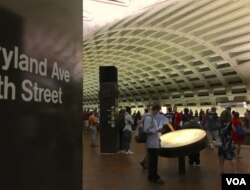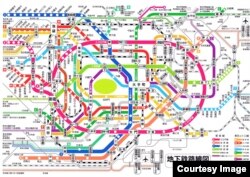A knot of tourists visiting Washington, D.C. crowds the escalator taking them underground to the subway platform at the L’Enfant metro station on a hot and humid August day. One man lingers in front of a circular map of the DC Metro system, trying to sort out which train goes where. It’s close to 4 p.m. and the platform is starting to fill up with regular commuters.
“Our subway system is so much bigger,” said Chris Percival, an Australian tourist who is standing over the map.
“I mean, it goes so much further outside Sydney — and, I hope you don’t mind if I say it, it’s just better,” he adds.
“I love the city, though,” Percival said as if to apologize for his assessment of the beleaguered subway system which opened 40 years ago in the nation’s capital.
Above ground, a local commuter waits in the heat for her ride home from work.
“Oh, no. I don’t take Metro now. Uh uh. No way,” says the 30-something African-American woman. Wearing professional dress and modest heels, she prefers not to give her name (she doesn’t like being searchable on the internet she says).
So why did she stop taking Metro?
“Oh my goodness, what made me stop? I’ll tell you, I used to rush to my train station, and there was no train, or the train was so crowded with too many people,” she said. “And then you know that accident that killed those riders in ’09 and a lady choked to death inside a train where smoke got in, right? I said no more after that one.”
DC Metro is in crisis. So much so that over the past few months, it closed for an entire day to conduct a system-wide emergency maintenance assessment.
Soon after, the newly appointed general manager announced a program known as SafeTrack, which has severely curtailed service to tackle serious safety breaches.
Metro General Manager Paul Wiedefeld’s office declined repeated requests for an interview with VOA.
How did Metro, built in one of the most powerful cities in the world (it’s home to the U.S. Congress and the White House), get to this point? How did a system that was described by President Barack Obama at one time as “a great strength of this region” deteriorate so dramatically?
Why has this public transport system become notorious for derailments, incidents involving smoke and fire, serious delays, and the tragic deaths of nine people in a 2009 accident and another fatality last year when smoke filled a car?
And how is it that other, much older subway systems — the London Tube, the Tokyo subway — are so much more reliable?
WATCH: Raw video from the 2009 fatal Metro collision
Maintenance
“The warning about maintenance came in the mid-1980s. The 1986 Federal City council report that said that the system was facing sharply rising higher maintenance costs in the 1990s as components began to wear out," said Zachary M. Schrag, author of the 2006 book "The Great Society Subway: A History of the Washington Metro," and a history professor at George Mason University.
“That prediction turned out to be accurate.”
Schrag also points out that there existed an incompatible tension: “the need to complete the system as initially envisioned and to rehabilitate it all at the same time.”
DC Metro, run by the Washington Metropolitan Area Transit Authority (WMATA), was planned all at once, Schrag explains. And it's a two-track system.
WMATA argues the two-track design makes it much harder to do maintenance or pull a disabled train off the rails without major disruptions during daily operations.
But critics counter that the Paris, London and other subways are also two-track systems, which function much better than DC Metro. The problem, critics say, is down to management.
DC's subway was also designed without a dedicated source of funding. WMATA, a collection of representatives from Washington, Virginia and Maryland, must go hat in hand to Congress to get funds.
And Congress can be moody, especially in the wake of numerous system failures and a damning report by the Federal Transit Agency, rebuking WMATA for failing to implement key safety measures
“Where you historically have unstable funding and you skimp on maintenance, which is paramount, you are bound to have big problems,” said transportation consultant Kevin Maher, a former 30-year-long career U.S. diplomat who lives in Tokyo. “[WMATA] doesn’t do regular maintenance.”
Different mindset
The Tokyo subway system is one of the world’s most consistently reliable, safe and admired.
VOA Correspondent Steve Herman can vouch for that, having lived 26 years in Asia, mostly Tokyo.
"You cannot underestimate the public mindset about public transportation in this part of the world," said Herman, who is now reporting from the State Department in Washington D.C. and now experiences firsthand the inefficiency of D.C.'s subway system.
"Over 90 years, incidents on the Japanese system have been rare," Herman said. "The Japanese are famous for efficiency in rail systems because the public mindset is that transportation systems are a critical part of daily life."
And the Tokyo system is run by a collection of private companies, not governments, points out Mahrer. He adds those companies factor in customer welfare and safety as key parts of their business models.
While the DC Metro, the second largest in the United States, is clearly in trouble, other American cities are struggling with serious problems plaguing their public transportation systems.
“Boston has a dedicated funding system,” said Schrag. “And it has billions of dollars in deferred maintenance. New York City has, I think, tens of billions of dollars of work that it wants done. You know, Chicago shut down a line.”
Having studied transit systems closely over a decade or so, Schrag has come to this conclusion about American subways:
“Really, it’s about the overall lack of investment in infrastructure.”












